
The Karamanids, also known as the Emirate of Karaman and Beylik of Karaman, was one of the Anatolian beyliks, centered in South-Central Anatolia around the present-day Karaman Province. From the middle 1300s until its fall in 1487, the Karamanid dynasty was one of the most powerful beyliks in Anatolia.

Karaman, historically known as Laranda, is a city in south central Turkey, located in Central Anatolia, north of the Taurus Mountains, about 100 km (62 mi) south of Konya. It is the capital district of the Karaman Province. According to the 2000 census, the population of the province is 231,872 of which 132,064 live in the town of Karaman. The district covers an area of 3,686 km2 (1,423 sq mi), and the town lies at an average elevation of 1,039 m (3,409 ft). The Karaman Museum is one of the major sights.

Eyalets, also known as beylerbeyliks or pashaliks, were a primary administrative division of the Ottoman Empire.

Anatolian beyliks were small principalities in Anatolia governed by beys, the first of which were founded at the end of the 11th century. A second more extensive period of foundations took place as a result of the decline of the Seljuq Sultanate of Rûm in the second half of the 13th century.

Osmangazi is one of the central metropolitan districts of the city of Bursa in Bursa Province, as well as the fourth largest overall municipality in Turkey. The municipality has a population of approximately 778,843 as of 2012. On its own, it would be the 28th largest city in Turkey.
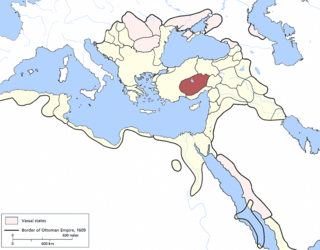
Karaman Eyalet was one of the subdivisions of the Ottoman Empire. Its reported area in the 19th century was 30,463 square miles (78,900 km2).
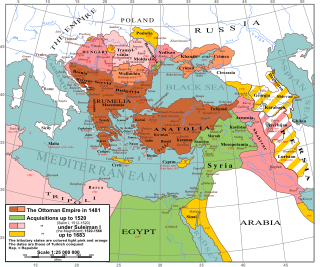
The Ramadanid Emirate was an autonomous administration and a de facto independent emirate that existed from 1352 to 1608 in Cilicia, taking over the rule of the region from the Armenian Kingdom of Cilicia. The emirate was a protectorate of the Mamluk Sultanate until the end of 14th century, then it was de facto independent for more than a century, and then, from 1517, a protectorate of the Ottoman Empire. The capital was Adana.
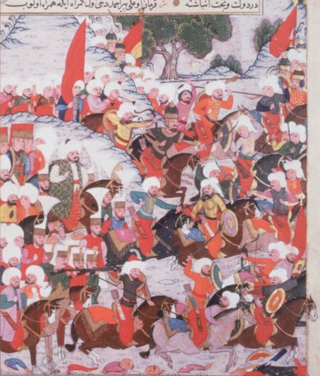
The Battle of Otlukbeli or Otluk Beli was a battle between Aq Qoyunlu and the Ottoman Empire that was fought on August 11, 1473.
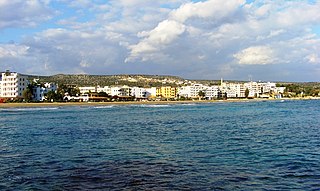
Kızkalesi is a town in Mersin Province, Turkey. The town, known in Antiquity as Corycus or Korykos, is named after the ancient castle built on a small island just facing the town.

Laal Pasha Mosque is a Medieval mosque in Mut in Mersin Province, Turkey.
Ibrahim II was a bey of Karaman.

Mamure Castle is a medieval castle in the Bozdogan village, Anamur ilçe (district) of Mersin Province, Turkey.
Mehmet II of Karaman, Mehmed Beg, Mehmed Beg II, also known as Nasir al-Din Mehmed Beg was the ruler of Karaman in what is now modern Turkey in the 15th century. His mother was Nefise Hatun, a daughter of Sultan Murad I.
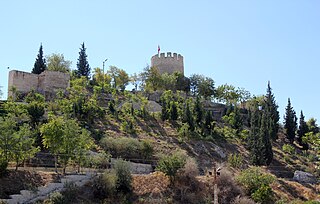
Mut Castle is a castle in Mut, Mersin Province, Turkey.
Kerîmeddin Karaman Beg (Turkish), sometimes Karaman Bey, was a Turkish chief founder of the dynasty Karaman-oğhlu or Karamanoğulları, a Turkish principality in Anatolia in the 13th century. The province and city of Larandia was renamed Karaman in his honor. He is well known for waging wars against the Byzantine Empire.

Kızkalesi is an island castle situated on a small island in Mersin Province of Turkey.
In the 18th and 19th centuries, Karamania was an exonym used by Europeans for the southern (Mediterranean) coast of Anatolia, then part of the Ottoman Empire. It can also refer to the general south central Anatolian region, whose name is reflected on the modern town of Karaman. It is also the namesake of the larger Karaman Province of Turkey, the historical Karaman Eyalet of the Ottoman Empire, the medieval Turkish Karamanids dynasty and state from the region, and the Karamanlides, a Turkish-speaking Orthodox Christian group originally from the area.

Kurvingrad or Koprijan (Копријан), is a ruined fortress which sits above the town of Doljevac on the South Morava river, 11 km south of the town of Niš. The ruins are all that remain of the medieval town of Koprijan from the time of Classical antiquity; the fortress is over a thousand years old. Today, fortifications remain, but have not been substantially studied.

Softa Castle is a ruined castle in Bozyazı ilçe (district) of Mersin Province, Turkey.

Karaman Museum is in Karaman, Turkey



















